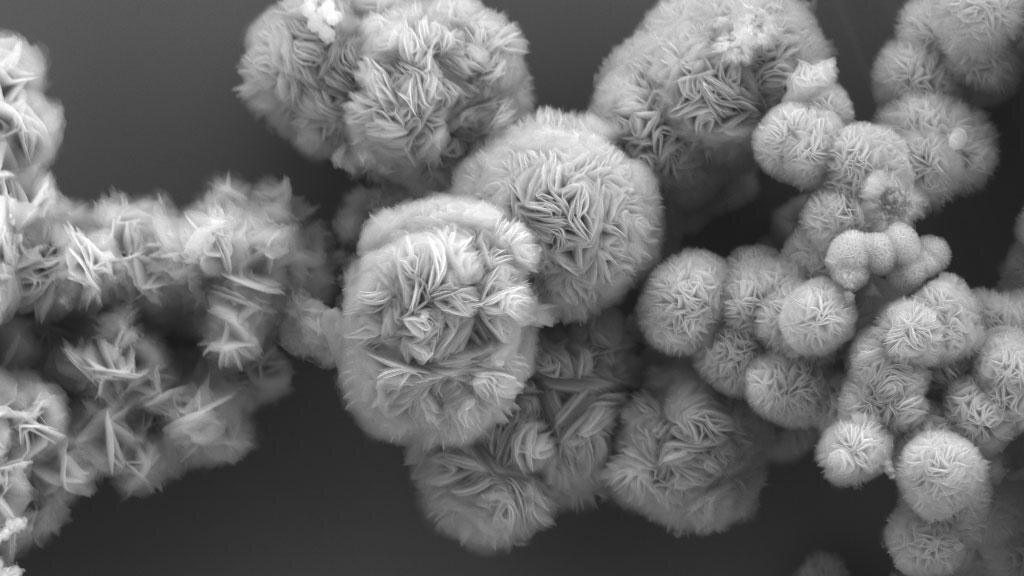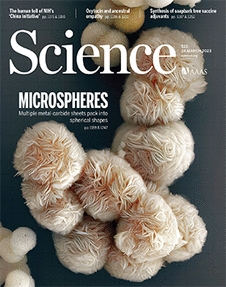博文
科学家们发现了一种简单的方法来制造原子薄的金属层
||
科学家们发现了一种简单的方法来制造原子薄的金属层
诸平


Fig. 2 Science, 2023, Volume 379, Issue-6638 cover
据美国芝加哥大学(University of Chicago, Chicago, IL, USA)2023年3月24日提供的消息,该校的研究人员与美国伊利诺伊大学芝加哥分校(University of Illinois Chicago, Chicago, IL, USA)以及美国阿贡国家实验室(Argonne National Laboratory, Argonne, IL, USA)的研究人员合作研究发现了一种简单的方法来制造原子薄的金属层(Scientists discover easy way to make atomically-thin metal layers for new technology)。
完美羊角面包(perfect croissant)的秘诀是尽可能多的层,每一层都点缀着黄油。类似地,一种有望应用于新领域的新材料是由许多极薄的金属层构成的,科学家可以在这些金属层之间放入不同的离子,以达到不同的目的。这使得它们对未来的高科技电子产品或能源储存非常有用。
直到最近,这些被称为MXenes(其中M为过渡金属,X为C或者N)的材料都是劳动密集型的,就像法式面包店(French bakery)制作的优质羊角面包一样。但美国的科学家们的一项新突破表明,如何更快、更容易地制造这些MXenes,同时产生更少的有毒副产品。相关研究结果于2023年3月23日已经在《科学》(Science)杂志网站发表,而且作为最新一期《科学》(Science)杂志的封面文章进行推介,详见上述图2(Fig. 2)所示——Di Wang, Chenkun Zhou, Alexander S. Filatov, Wooje Cho, Francisco Lagunas, Mingzhan Wang, Suriyanarayanan Vaikuntanathan, Chong Liu, Robert F. Klie, Dmitri V. Talapin Direct synthesis and chemical vapor deposition of 2D carbide and nitride Mxenes. Science, 2023, 379 (6638): 1242-1247. DOI: 10.1126/science.add9204. Epub 2023 Mar 23. https://www.science.org/doi/10.1126/science.add9204
研究人员希望这一发现将刺激新的创新,并为在日常电子产品和设备中使用MXenes铺平道路。
原子经济(Atom economy)
当它们在2011年被发现时,MXenes让许多科学家非常兴奋。通常,当你把金或钛这样的金属刮成原子薄的薄片时,它就不再像金属了。但是MXenes中异常强的化学键使它们保留了金属的特殊能力,比如强导电性。
它们也很容易定制:“例如,你可以把离子放在层之间,用它们来储存能量,”化学研究生王迪(Di Wang音译)说。王迪与博士后学者周晨坤(Chenkun Zhou音译)二人是上述论文的共同第一作者。
所有这些优点都可以使MXenes在制造新设备方面非常有用,例如储存电力或阻止电磁波干扰。
然而,我们所知道的制造MXenes的唯一方法涉及几个密集的化学工程步骤,包括在3000℉加热混合物,然后在氢氟酸(hydrofluoric acid)中浸泡。
芝加哥大学欧内斯特·德威特·伯顿杰出服务化学教授(Ernest DeWitt Burton Distinguished Service Professor of Chemistry at the University of Chicago)、阿贡国家实验室联合任命教授、该论文的通讯作者德米特里·塔拉宾(Dmitri Talapin)解释说:“如果你在实验室里制造几克用于实验,这是没有问题的,但如果你想制造大量用于商业产品,这将面临一个主要的腐蚀性废物处理问题。”
为了设计一种更有效、毒性更小的方法,该团队使用了化学原理,特别是“原子经济”原理,该原理旨在最大限度地减少反应过程中浪费的原子数量。
为了设计一种更有效、毒性更小的方法,该团队使用了化学原理,特别是“原子经济”原理,该原理旨在最大限度地减少反应过程中浪费的原子数量。
美国多家机构研究人员组成的研究小组发现了新的化学反应,使科学家能够从简单而廉价的前体中制造MXenes,而不使用氢氟酸。它只包括一个步骤:将几种化学物质与你想要制造层的金属混合,然后将混合物加热到1700 ℉。“然后你打开它,它们就在此,”王迪说。
这种更简单、毒性更小的方法为科学家创造和探索用于不同应用的MXenes新品种开辟了新的途径,例如不同的金属合金或不同的离子填充物。研究小组用钛(titanium, Ti)和锆(zirconium, Zr)金属测试了这种方法,但他们认为这种技术也可以用于许多其他不同的组合。
王迪补充道:“这些新的MXenes在视觉上也很漂亮。它们像花朵一样竖立起来,这甚至可能使它们更适合于反应,因为边缘暴露在外,离子和分子可以在金属层(metal layers)之间移动。”
本研究得到了美国国家科学基金会(National Science Foundation: DMR-2004880, DMR-2011854, DMR-1848306, DMR 1831406, DMR-0959470, DMR-1626065)、美国国防部(U.S. Department of Defense: FA9550-22-1-0283, FA9550-20-1-0104)、阿贡国家实验室(Argonne National Laboratory, Office of Science: DE-AC02-06CH11357)以及美国能源部{U.S. Department of Energy: Advanced Materials for Energy-Water-Systems (AMEWS) EFRC}的资助。
在《科学》(Science)的同期还刊登了来自美国加州大学洛杉矶分校(University of California, Los Angeles, Los Angeles, CA, USA)研究人员的与MXenes相关的评述论文——Daniel D. Robertson, Sarah H. Tolbert. A direct and clean route to Mxenes. Science, 2023, 379(6638): 1189-1190. DOI: 10.1126/science.ade9914. Epub 2023 Mar 23. https://www.science.org/doi/10.1126/science.ade9914
上述介绍,仅供参考。欲了解更多信息,敬请注意浏览原文或者相关报道。
MXenes without MAX phases(DOI: 10.1126/science.add9204)
Two-dimensional metal carbides and nitrides, or MXenes, have several potential applications in energy storage and electronics. They are usually made by delamination of a layered parent compound, a MAX phase, in a harsh etching step. Wang et al. synthesized one of the most widely used MXenes, Ti2CCl2, as well as MXenes not available from MAX phases, using chemical vapor deposition (see the Perspective by Robertson and Tolbert). The reaction of methane and titanium tetrachloride on a titanium surface led to the growth of Ti2CCl2 sheets perpendicular to the metal. Under some growth conditions, the sheets could buckle off the surface to form vesicles. —PDS
Abstract(DOI: 10.1126/science.add9204)
Two-dimensional transition-metal carbides and nitrides (MXenes) are a large family of materials actively studied for various applications, especially in the field of energy storage. MXenes are commonly synthesized by etching the layered ternary compounds, called MAX phases. We demonstrate a direct synthetic route for scalable and atom-economic synthesis of MXenes, including compounds that have not been synthesized from MAX phases, by the reactions of metals and metal halides with graphite, methane, or nitrogen. The direct synthesis enables chemical vapor deposition growth of MXene carpets and complex spherulite-like morphologies that form through buckling and release of MXene carpet to expose fresh surface for further reaction. The directly synthesized MXenes showed excellent energy storage capacity for lithium-ion intercalation.
Abstract (DOI: 10.1126/science.ade9914)
Materials with layered crystal structures are an emerging class of compounds with desirable properties for numerous applications. In particular, the family of two-dimensional (2D) transition-metal carbides and nitrides (1) known as MXenes [where M is a transition metal and X is carbon (C) or nitrogen (N)] have shown exciting prospects for use in energy storage (2), electromagnetic interference shielding (3), transparent conductors (4), and more (5, 6). However, MXenes have only been synthesized from MAX phases [where A is typically aluminum (Al) but can sometimes be other elements] by chemically removing A atoms with harsh solutions (7). Because this method generates large amounts of waste, it limits the scale of manufacturing for MXenes and hinders their utility. On page 1242 of this issue, Wang et al. (8) report the direct synthesis of MXenes by use of direct, scalable synthetic methods. These approaches also open pathways to produce new morphologies and phases of MXenes that have not been accessible by the typical route.
https://blog.sciencenet.cn/blog-212210-1382093.html
上一篇:量子突破:对量子湍流的新认识
下一篇:足球型分子是如何在宇宙中产生的?